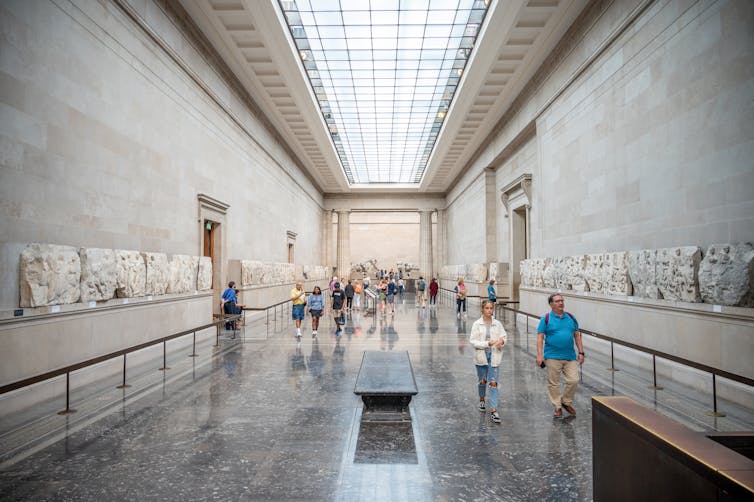George Osborne – former UK chancellor and now chair of trustees at the British Museum – is reported to have negotiated the repatriation of the 2,500-year-old Parthenon marbles to Athens.
The deal, struck with the Greek prime minister, Kyriakos Mitsotakis, is not yet finalised. But it is thought that the sculptures will leave London “sooner rather than later” and it is planned that the British Museum will receive some ancient artefacts in return.
Early in the 19th century, the marbles were removed from the Parthenon by employees of Lord Elgin, then the British ambassador to the Ottoman empire. There is evidence that he wanted them to decorate Broomhall House, his estate in Scotland.
But Lord Elgin ran short of cash. After extended bartering, he eventually sold the sculptures, images of both gods and mythic battle, to the British government for £36,000 – much less than the costs he incurred in removing them from the Acropolis.
The sculptures were deposited in the British Museum, under the care of its trustees. From that point on, they have attracted controversy. Greek politicians have made repeated requests for repatriation.
What would the return of the Parthenon marbles signify?
The return of the Parthenon marbles would be a historic moment. In bringing it about, Osborne is not acting alone. As chair of trustees, he shares decision-making powers with a high-profile museum board, which includes historian Mary Beard and artist Grayson Perry.

Behind the scenes, there are also politics at play. Most of the museum trustees are appointed by the British prime minister. They then elect their chair.
Last year, around the same time that Osborne’s negotiations started, the Greek prime minister had tabled repatriation as an item for discussion at a Downing Street meeting with Boris Johnson.
Whatever the backroom role of the British government, repatriation would not be possible without Osborne’s positive support. This is true, even while the former chancellor’s motivation might not be entirely selfless. He now – like Lord Elgin – has the chance to associate his name with the artworks in perpetuity.

This potential personal ambition is not legally straightforward. The British Museum is formally a charity and Osborne must put the best interests of the organisation before all else. He must account for any negative consequences flowing from repatriation.
The issue is not clear cut. Although the museum will lose its prize exhibit, and may have less visitors, the return of the marbles will generate intense press publicity – and perhaps some goodwill – around the world.
The ethical – and perhaps legal – basis of the original British purchase is certainly doubtful. Lord Elgin received legal permission from local Ottoman authorities but the most likely view is that, in removing a very large number of sculptures over a sustained period, Lord Elgin went further than the original document allowed.
Lord Elgin then sought a new legal permission from the Sultan, sanctioning removal “after the fact”.
Can George Osborne legally return the Parthenon marbles?
Even accepting all this, Osborne still cannot lawfully “deaccession” the Parthenon marbles. Under the British Museum Act 1963, such action is permitted only if objects are “unfit to be retained”. The legislation is primarily intended to cover extreme circumstances, such as human remains found in store.
Osborne’s plan, as it is reported, has found a way around this legal problem. His scheme is for the marbles to be loaned.
Ownership would be kept by the British Museum, even while the marbles will be rehoused in Athens. As a matter of law, it will be possible to claim that the sculptures have not, strictly speaking, been deaccessioned.
Once the marbles are rehoused in the specially built Acropolis Museum, it is unlikely that they will ever return to London. Any request from future museum trustees would be met with a cold shoulder.
And so the “loan” would permanently restore the sculptures to Athens, while leaving the British Museum Act 1963 and its general bar on deaccession intact.

It is a carefully constructed legal plan, but it could also be a missed opportunity. Over the coming decades, pressure on the British Museum to repatriate other objects, such as the Benin bronzes, and the Rosetta Stone will probably grow.
Read more: Rosetta Stone: a new museum is reviving calls to return the artefact to Egypt
If the scheme marks any type of precedent, the British Museum will respond to other requests through similar backroom negotiations. The British government will keep the nature of its involvement both ambiguous and at arm’s length.
It would be better to move forward in a spirit of transparency. It is still widely thought that deaccession is politically unpopular. But in changing times, that view might now be out of date.
A bold government which, through special legislation, took direct responsibility for repatriation, might find popular support.

